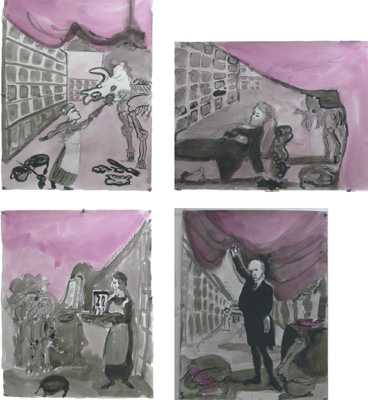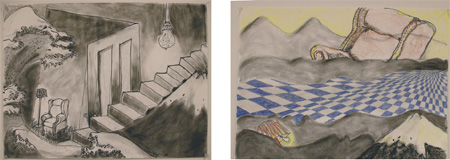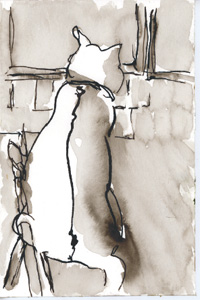
It sounds so dumb to say it so baldly, but I’ll say it baldly anyway. I love to draw. I can’t remember back to before a time when I didn’t draw: racehorses in the sports pages, courtroom scenes, paper dolls and their clothes. The joy of larkish Saturdays drawing with high school art Teacher Sam and the rest of the multicolored mob of the Oakland Tech High Art Club. Heedless, thankfully, of insurance liability and seeming not to mind our many colors back well before multiculturalism in California, Teacher Sam took us on sketching trips around the Bay Area: to Chinatown in San Francisco, to Marin County, and to Fort Cronkhite, with its battle-gray Cold War military remains, where we connected our eyes to our hands to our ravishing Bay Area.
After I graduated from high school, Sam got his MFA at California College of Arts and Crafts and pursued every artist’s dream of New York City fame. Sam did not become a famous New York painter and, like many another local artist, came back home. He became a sculptor and made a career teaching art at San Jose State University. Sam died in 2013. In high school I also took drawing classes at CCAC, where Richard Diebenkorn’s memory and the Bay Area Figurative School modeled the right way to draw. I still feel their influence. Margo Humphrey, my sister student at CCAC, stayed in art and became a prominent printmaker. Two prints she made as an artist-in-residence at the Brodsky Center at Mason Gross hang in our house in Newark.
At Mason Gross I had started with the kind of drawings you make in undergraduate art school, where you learn to make marks, to see by making marks, to trust your line—not to be distracted by color—to align your eye and your hand and your mark. At first it’s simple objects, for one goal of this kind of drawing is to reproduce the appearance of things in the world, called mimesis. I knew some of this when I was in high school, maybe even all of this I knew. But in my decades as a historian and not drawing, I forgot what I used to know. Now I went back to drawing’s history in the way history always captivates me.
Drawing goes way back in human history to scratches on rocks and paintings in caves, to persuade the gods, manipulate nature, entice animal prey, keep notes, and, most basically, to please the eye. So many useful roles for images to play. Art-school drawing, I mean self-conscious art drawing, dates to the Renaissance, to the fifteenth-century masters Leonardo and Michelangelo and the sixteenth-century Accademia del Disegno of Giorgio Vasari in Florence. Disegno you can translate as “design” as well as “drawing.” Vasari’s Lives of the Most Excellent Painters, Sculptors, and Architects is considered art history’s foundational text. Intrigued by Vasari as painter as well as biographer, writer as well as teacher of drawing, I bought a paperback copy to check out Vasari’s comments on artists’ techniques and his admiration of Leonardo’s drawing.
Drawing is the fountainhead, the well. Here lie the roots of the master drawings of painters like Dürer and Rembrandt, whose skilled studies of the figure count as fine art in their own right, even though they were made as exercises or sketches for assistants. Leonardo and his contemporaries conveyed volume with cross-hatch and distance with perspective, so that just browsing Leo-nardo’s voluminous sketchbooks—his studies of people, animals, maps, buildings, machines, and fantastically detailed draftsmanship—might intimidate you out of ever picking up your own pen. And to think that those drawings are simply considered “studies.”
Hardly anybody draws like that anymore. Hardly anybody even strives to draw like that, though I know of an exception, the New York Academy of Art. I spent a weekend there learning to draw faces, examining and drawing the actual shape of the human eye. Well, the actual shape of the human eye in art history as depicted in the Italian Renaissance. On the second day we had a Latino model whose eyes were New Yorker shaped. It was a good, useful lesson to look hard at Renaissance-Italian eyes, then to really see non-Renaissance-Italian eyes.
The New York Academy of Art preserves the Renaissance tradition, even down to making écorchés. Literally something flayed, an écorché is a body with the skin taken off to reveal the muscle, bone, and sinew. Interestingly, one of the most striking examples of the rendering of musculature is an etching rather than a drawing: Antonio Pollaiuolo’s Battle of the Ten Nudes (1470–75), in which every single muscle of the contending warriors is tensed. They look, as Leonardo once said, “like a sack of nuts rather than the surface of a human being, or indeed a bundle of radishes rather than muscular nudes.” Leonardo wasn’t talking about Pollaiuolo; he was sneering at Michelangelo’s figures. But the description still fits. Leonardo’s own sketchbooks are full of écorchés of humans and animals. He could have built a person or a horse from scratch. For centuries écorchés were considered the basis of figure drawing. But not anymore, at least not in most American art schools. Too hard. Too time consuming, even where mimetic drawing still plays its role.
All beginning art students in the twentieth century studied mimetic drawing as the foundation of visual arts—until conceptual art began dematerializing art in the 1960s, so that the thought, the concept, mattered as much, maybe more, than the thing, and the artist didn’t have to make the art at all. For conceptual art, drawing is passé, to my mind a crucial loss of intense seeing—call it mindful sight. In traditional drawing class, you began by drawing simple forms—spheres, cones—and worked up to the human body. For this kind of pedagogy, the nude was where you honed your skill. Even when drawing was considered an end in itself—not merely as a sketch or basis for a painting or sculpture—it culminated in the nude. In my drawing and painting marathon at the New York Studio School, there was a nude model in a set-up in every studio for every assignment.
BEYOND THE SATISFACTION of making an image, I always liked drawing as a means of slowing down, of really seeing what I was looking at. The singer-songwriter Abbey Lincoln called it looking at what you see, a lesson she took from her own mother. When I’m drawing, I look at more; I see more. I still can’t draw as expertly as my friend Madeleine, who earned her MFA in Boston in the 1970s, when and where mimetic drawing was still an essential skill. But the ability to make my drawing look like something in the world, like the “motif,” has always mattered less to me than the profound pleasure of making my marks on paper. What satisfies me is the process itself, the alliance of paper and ink or pencil or charcoal or any of myriad new markers and even objects like twigs dipped in ink or powdered graphite. My drawings don’t further some other project. Tiny or large, they’re artifacts in their own right.
Drawing like this feels spontaneous—I see what I have made as soon as I make it. And because of its small scale, it feels intimate. My paper usually fits on my lap or under my arm. I can carry drawing around to work on at any time. I like to draw on smooth Bristol paper, because paper with tooth distracts my line. I also use Yupo, a slick, synthetic polypropylene paper that doesn’t absorb ink or graphite easily and produces unexpected textures from watery mediums like ink. Sometimes I do use color in my drawings, but I like deep black India ink, using the dropper as a mark-making tool. Especially in abstract drawings, I collage torn-up pages of art magazines with their good, heavy paper and vivid color. Gallery advertisements let me quote the work of other artists and sneak in a touch of art history to add more than purely visual meaning.
As I think now about my love of drawing, I confront the underlying reality of drawing’s lack of painting’s prestige. Drawings are usually smaller than paintings and on paper, communicating the fragility of the ephemeral, as opposed to canvas, especially canvas on stretcher bars that communicate solidity and permanence. A medium of surpassing simplicity, drawing connects the hand directly with the support, without the interference of paint—paint, I mean, as an ennobling medium. Drawings lack paintings’ gravitas and are generally considered less important and therefore less valuable—okay, cheaper—than painting. Drawings are to paintings as bungalows are to castles. This can be a good thing. To me—a famously bad painter—drawing seems more accessible and less intimidating, its stakes lower. I can make many, many drawings without exceeding my skills or wasting materials. In this sense, my attraction to drawing is one facet of my low self-esteem as an artist, perhaps even my own low self-esteem as a woman artist. I don’t like to think that way, but such thoughts blow in with the atmosphere.
I LOVED AND still love Teacher Hanneline, my Norwegian Mason Gross drawing instructor who didn’t have an American prejudice against organization. I like to think my admiration for her grew out of the thoughtfulness of her teaching, her care in connecting vision to image. I admire the tender way she inhabits the world and how she looks, her attentiveness, her sideways smile, her solid, not too thin, not too fat physical presence. I would say she is beautiful, but American capitalism, with its skinny glamour of industrial beauty, has corrupted the concept of physical beauty. Hanneline is more than beautiful. Is she truly as serene about her looks as I thought? I know she “curated” (as we say) her appearance, emerging from Brooklyn in unmistakable artist’s costume. She showed me how to look like an artist.
In Hanneline’s class we started with charcoal, drawing bones that were one part simple shapes and another part convoluted, textured forms. She moved us on to ink, exposing us to drawings by various artists: the performance artist Joseph Beuys, the architect Walter Pichler, the outsider artist Bill Traylor, the silhouette master Kara Walker, the Romantic painter Francisco Goya, and the Bay Area–Los Angeles expressionist Richard Diebenkorn. I carried her exercise on pentimento into work that stayed with me into graduate school. Pentimento refers to traces of original drawing that the artist has erased. In the work of someone like William Kentridge, pentimento conveys a feeling of a shadowy presence of something that has gone before and remains a memory with visual meaning. All Hanneline’s artists were different, so we could see the scope of drawing’s possibilities exceeding any one, single, correct way to draw. The trick was to draw a lot, like Vincent van Gogh.
In letters to his brother Theo, van Gogh talked about doing nothing but drawing and drawing and drawing. How I envied him this. He drew before painting for two whole years and still wanted to learn more, particularly about the figure, which to him, as to other artists, stood at the apogee of art. He talked about color, especially the grays, and various drawing instruments. He said that soaking charcoal in oil produced a nice deep black, and that dashing milk over drawings gave them a nice sheen. Nowadays we have compressed charcoal for intense blacks and acrylic polymer gloss medium for sheen. The part of van Gogh’s drawing process I adopted was rectangular carpenters’ pencils with their cunning little sharpener (mine in cadmium-orange plastic), so they make lines of different thicknesses according to how you hold the pencil. Drawing isn’t only about the line. But for me, the essence of drawing is line.
Hanneline’s drawing classes challenged me. After bones, we did research. We made drawings based on paintings from art history, imagined images frontways and from the back, before, during, and after the scene in the original. I drew The Artist in His Museum, by Charles Willson Peale, from 1822. I knew Peale to be a naturalist who wanted Americans to appreciate their physical world. The Artist in His Museum appealed to me as American history set in a particular place, Philadelphia, and as an over-the-top self-portrait advertising a collection of natural history artifacts. At 8' 8" × 6' 8", Peale’s painting is larger than life-size. There’s a dinosaur skeleton behind the curtain Peale lifts, mastodon bones in the foreground (in 1806 Peale had painted the exhumation of the first American mastodon), a collection of birds, actual and extinct, arranged on orderly shelves in precipitous one-point perspective, and, at his feet, a dead wild turkey, splendid in its plumage. Visitors in the background. On the table behind him, Peale’s palette with paints in an orderly arrangement beside his brushes. Peale’s stagey gesture of revelation is proudly deadpan, instructing an innocent American public, a Philadelphia of science in its youth, not yet feeling the need for irony. At the time, Peale was eighty-one years old.
My version uses a more simplified palette than The Artist in His Museum, and, of course, my pieces are much smaller and on paper rather than canvas. Drawn in ink with only rose as color, my before the scene shows a serving woman tidying up before Peale appears. While she works, he naps. There’s no mirror or pinhole camera, the devices he would have used to aid his composition. Once the woman’s work is done, Peale poses alone for his masterwork.

UPPER LEFT: Peale Drawing 1, 2008, ink on paper, 23" × 18"
UPPER RIGHT: Peale Drawing 2, 2008, ink on paper, 18" × 23"
LOWER LEFT: Peale Drawing 3, 2008, ink on paper, 23" × 18"
LOWER RIGHT: Peale Drawing 4, 2008, ink on paper, 23" × 18"
Drawing for Hanneline fueled my imagination. It wasn’t just the images as I drew them. It was everything surrounding the images. As Jacques Derrida would say, there’s no beyond the frame; everything, whether you think it belongs in the picture or not, brings meaning to the image (or, in literature, to the text). Drawing for Hanneline reached back into my own autobiography to trace the Bay Area’s influence on my eyes.
I grew up looking at territory delimited by mountains, my Oakland horizon bounded by the Coast Range east and west of the San Francisco Bay. I learned to drive on a stick shift on Bay Area hills, at steep stoplights—brake, clutch, accelerator in a careful sequence—without rolling backward into cars lined up behind. My first car was an English roadster I drove around with the top down until the temperature dropped into the forties—rare in Oakland back in the twentieth century. Hills, mountains, triangle-shaped lines cross my drawings, just as they taught me how to drive.
My hand and eye sought mountains as necessary to compose a landscape, even an indoor scene with lamp and easy chair. I needed a bumpy horizon line and drew mountains in charcoal with Hokusai waves and Mount Fuji in the upper left or lower right, a Philip Guston lightbulb above, an easy chair interior, and an ultramarine blue checkerboard to quote Robert Colescott. I drew a lot for Hanneline.
In the last group crit of the spring semester, Hanneline mentioned her Yale School of Art assignment of one hundred drawings. One hundred drawings. I could do that. Hell, I could do that right now. A nice round number, impressive in its own right. Make one hundred drawings. One student groaned, a couple of others held their tongues. One hundred drawings! How could we ever make one hundred drawings?!

LEFT: Hokusai Composite Drawing, 2008, ink and graphite on paper, 18" × 24"
One hundred drawings’ intoxication. By the end of the summer, I reckoned, even with The History of White People (which I sometimes shortened to THWP), the fucking, everlasting Organization of American Historians, and book-prize-committee chairing, I could make one hundred drawings, twice one hundred drawings. No, let me be reasonable and leave the goal at one hundred—one hundred drawings during the summer.
Ink and a new sketchbook launched my one hundred drawings starting on the first day of summer vacation in late May in Newark. Our backyard. New Jersey really is the green and glorious Garden State.
New Jersey spring has flowering trees like in the South, but you don’t have to dread the South’s day-after-day-after-day of ninety-five degrees, June to October. You don’t have to scuttle between air-conditioned home and air-conditioned office. Heat doesn’t punch you in the face when you open your car door in the supermarket parking lot. You don’t have to sweat absolutely all the time. Sweet spring in Newark, New Jersey. Come outside. Draw.
On such a fine May morning in Newark I took my sketchbook to the backyard with a bottle of ink, a pen, and a brush. I sat at the glass table looking over our tiny, earnest backyard farm with the pretty, vain, fat brown tabby cat surveying his domain.

Ro, 2008, ink on paper, 7" × 5"
All summer I continued drawing, alternating stabs at writing my book and history organization chores. All summer I made small drawings, representational, figurative, and abstract. I called the project One Hundred Drawings for Hanneline, though there are really only sixty-seven.